The Federal Bureau of Investigation (FBI) is a federally funded intelligence agency, and is the prime source of investigative resources for the U.S. Department of Justice. Currently, the FBI is responsible for more than 200 federal crime categories, and boasts the widest authority and jurisdiction of any federal law enforcement firm. Its motto is “Fidelity, Bravery, Integrity.”
Its headquarters are in Washington, D.C.
The bureau's birth
In 1908, the bureau was born as a force of special agents, which was created by Attorney General Charles Bonaparte during Theodore Roosevelt's presidency. The agency became known as the Bureau of Investigation, and was re-named as the Federal Bureau of Investigation (FBI) in early 1935. At its outset, the Bureau of Investigation predominantly recruited men who had prior experience in law enforcement.
Federal crimes were not a major problem in the country when the bureau was initiated. Most common violations that received the bureau's attention involved national banking fraud, land fraud, various forms of enslavement, and extortion.
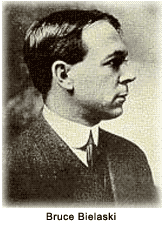 In June 1910, the Mann ("White Slave") Act became an important tool for the bureau. The Mann Act made it illegal for women to be transported across state lines for immoral purposes, which in turn, gave the bureau the right to investigate non-law-abiding citizens who had eluded prosecution by leaving a certain state. The Bureau of Investigation also used the Mann Act to bring Louisiana's Ku Klux Klan "Imperial Kleagle" to justice. In 1912, former Special Examiner, Bruce Bielaski, became the bureau's new chief.
From 1912 to 1914, the Bureau of Investigation employed some 300 special agents assigned to various federal crimes, as well as more than 300 other office personnel offering support and logistics to field agents. Field offices were placed in many major U.S. cities, and each field operation was run by one special agent who worked directly with headquarters in Washington. Although those outposts were primarily placed in larger cities, the demand for a presence near the Mexican border soon became evident, and compelled the placement of outposts in smaller border towns to investigate various instances of illegal smuggling.
From 1921 to 1933, the bureau was often at odds with a frustrated public. During what were called the "lawless years," many Americans resisted the establishment of Prohibition, while others were involved in extremist politics. The Treasury Department, not the Justice Department, had jurisdiction over the unlawful use of intoxicating beverages. With the transportation of alcohol across state lines, however, bureau agents also were brought in to investigate. Raids of speakeasies (nightclubs serving alcohol) and the use of decoy speakeasies brought about the arrests of many bootleggers (alcohol smugglers) during Prohibition.
In June 1910, the Mann ("White Slave") Act became an important tool for the bureau. The Mann Act made it illegal for women to be transported across state lines for immoral purposes, which in turn, gave the bureau the right to investigate non-law-abiding citizens who had eluded prosecution by leaving a certain state. The Bureau of Investigation also used the Mann Act to bring Louisiana's Ku Klux Klan "Imperial Kleagle" to justice. In 1912, former Special Examiner, Bruce Bielaski, became the bureau's new chief.
From 1912 to 1914, the Bureau of Investigation employed some 300 special agents assigned to various federal crimes, as well as more than 300 other office personnel offering support and logistics to field agents. Field offices were placed in many major U.S. cities, and each field operation was run by one special agent who worked directly with headquarters in Washington. Although those outposts were primarily placed in larger cities, the demand for a presence near the Mexican border soon became evident, and compelled the placement of outposts in smaller border towns to investigate various instances of illegal smuggling.
From 1921 to 1933, the bureau was often at odds with a frustrated public. During what were called the "lawless years," many Americans resisted the establishment of Prohibition, while others were involved in extremist politics. The Treasury Department, not the Justice Department, had jurisdiction over the unlawful use of intoxicating beverages. With the transportation of alcohol across state lines, however, bureau agents also were brought in to investigate. Raids of speakeasies (nightclubs serving alcohol) and the use of decoy speakeasies brought about the arrests of many bootleggers (alcohol smugglers) during Prohibition.
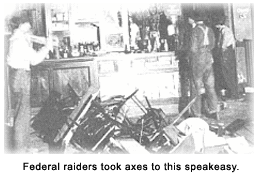 Such lawlessness had its roots in Organized Crime, and the bureau was deeply involved in rooting it out. The capture of such criminals as "Machine Gun" Kelly, bank robber John Dillinger, and "Baby Face" Nelson became urgent priorities and the bureau gained public respect in their part in taking those thugs down.
The Hoover years
On May 10, 1924, 26-year-old J. Edgar Hoover became the bureau's director. At the beginning of his watch, Hoover integrated into the bureau a badly needed reorganization of policies. He established a special agent training academy, with a minimum entry age of between 25 and 35 years of age, and by the end of the Twenties, he had fused the coordination of all field offices with centralized files containing fingerprint cards.
Further, Hoover officially opened the FBI Scientific Crime Detection Laboratory (a.k.a. FBI Crime Lab) on November 24, 1932. Today, the crime lab is one of the largest and most comprehensive of its kind in the world and is the only full-service forensics lab. It performs crime scene searches, surveillance, fingerprint examinations, and other scientific and technical services. The bureau also trains state and local crime laboratory and law enforcement personnel from all over the country, at the FBI Academy in Quantico, Virginia.
Such lawlessness had its roots in Organized Crime, and the bureau was deeply involved in rooting it out. The capture of such criminals as "Machine Gun" Kelly, bank robber John Dillinger, and "Baby Face" Nelson became urgent priorities and the bureau gained public respect in their part in taking those thugs down.
The Hoover years
On May 10, 1924, 26-year-old J. Edgar Hoover became the bureau's director. At the beginning of his watch, Hoover integrated into the bureau a badly needed reorganization of policies. He established a special agent training academy, with a minimum entry age of between 25 and 35 years of age, and by the end of the Twenties, he had fused the coordination of all field offices with centralized files containing fingerprint cards.
Further, Hoover officially opened the FBI Scientific Crime Detection Laboratory (a.k.a. FBI Crime Lab) on November 24, 1932. Today, the crime lab is one of the largest and most comprehensive of its kind in the world and is the only full-service forensics lab. It performs crime scene searches, surveillance, fingerprint examinations, and other scientific and technical services. The bureau also trains state and local crime laboratory and law enforcement personnel from all over the country, at the FBI Academy in Quantico, Virginia.
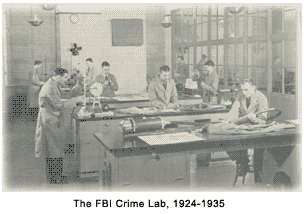 Beginning in the Forties, the bureau tackled cases of espionage in the U.S. As many as eight Nazi agents who had planned terrorism against various U.S. targets were taken "downtown" by FBI agents. Authorized by the National Security Act of 1947, the FBI began counterintelligence operations to prevent sensitive information from falling into the hands of enemies of the nation. The bureau collected political and military information, and intercepted subversive and sabotage activities. The FBI employed many such counterintelligence programs, beginning in the 1950s.¹
Since 1949, the FBI's Ten Most Wanted Fugitives list has been at the disposal of agents to work with other law enforcement agencies and the general public, to help capture dangerous fugitives.
The FBI formed “COINTELPRO” (an acronym for counterintelligence services) to "neutralize" political dissidents in the United States between 1956 and 1971. Convinced that such radical social groups were a cover for communist-front organizations, Hoover used COINTELPRO at least 2,000 times to “neutralize” civil-rights, antiwar, and numerous other groups. When COINTELPRO was exposed in 1971, the bureau discontinued its operations.
Over his several decades as director, Hoover unfortunately spent much of the agency's resources investigating innocent socialists and other assorted political activists — frequently amassing huge files on individuals in the process. Such notable Americans as Eleanor Roosevelt, who had the thickest personal file, and Martin Luther King Jr., were the objects of the director's scrutiny.
Beginning in the Forties, the bureau tackled cases of espionage in the U.S. As many as eight Nazi agents who had planned terrorism against various U.S. targets were taken "downtown" by FBI agents. Authorized by the National Security Act of 1947, the FBI began counterintelligence operations to prevent sensitive information from falling into the hands of enemies of the nation. The bureau collected political and military information, and intercepted subversive and sabotage activities. The FBI employed many such counterintelligence programs, beginning in the 1950s.¹
Since 1949, the FBI's Ten Most Wanted Fugitives list has been at the disposal of agents to work with other law enforcement agencies and the general public, to help capture dangerous fugitives.
The FBI formed “COINTELPRO” (an acronym for counterintelligence services) to "neutralize" political dissidents in the United States between 1956 and 1971. Convinced that such radical social groups were a cover for communist-front organizations, Hoover used COINTELPRO at least 2,000 times to “neutralize” civil-rights, antiwar, and numerous other groups. When COINTELPRO was exposed in 1971, the bureau discontinued its operations.
Over his several decades as director, Hoover unfortunately spent much of the agency's resources investigating innocent socialists and other assorted political activists — frequently amassing huge files on individuals in the process. Such notable Americans as Eleanor Roosevelt, who had the thickest personal file, and Martin Luther King Jr., were the objects of the director's scrutiny.
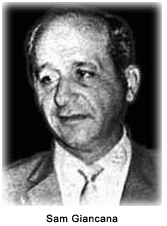 After Hoover
Organized crime continued to feel the FBI's relentless pressure. Surveillance operations conducted against the families of Sam Giancana and John Gotti ultimately resulted in the break-up of such criminal organizations. A former driver and hired killer for Al Capone’s successor, Frank “The Enforcer” Nitti, Giancana was believed to have been one of those gangsters recruited by the CIA to assassinate Cuban President Fidel Castro. Owing to his high-profile lifestyle and intense surveillance by the FBI, Giancana was dethroned by the Mafia and later assassinated in his Illinois home in June 1975 upon his return from exile in Mexico. A flurry of other FBI investigations during the 1970s and 1980s somewhat blunted the Mafia's power.
In a 51-day standoff outside Waco, Texas, in 1993, the FBI, ATF (Bureau of Alcohol, Tobacco and Firearms), and Texas Rangers unsuccessfully attempted to rescue Branch Davidians thought to be held hostage by their leader, David Koresh in their compound called Mount Carmel. The FBI employed their Hostage Rescue Team (HRT) and Special Agent in Charge (SAC) from the San Antonio office to carry out counter-terrorist tactics on Koresh. On that fateful day in April 1993, newly sworn U.S. attorney general Janet Reno approved the use of chlorobenzylidene malononitrile (CS) gas to neutralize the compound's defenders. The confrontation led to the deaths of all but 10 of Koresh’s followers. The ATF and FBI were later accused of excessive force in what began as an investigation into Koresh’s "gun business," and ended in an ungulfing fire and the deaths of most adherents inside the compound.
The FBI has confronted turncoats. For instance, in February 2001, the bureau reported that one of its own men, Robert Hanssen, worked for the Soviets by releasing secret U.S. intelligence to them for 15 years. The alleged spy was reportedly exposed by a mole²-hunting team.
On February 24, 1994, Aldrich Ames, a 31-year veteran of the Central Intelligence Agency (CIA), was apprehended by the FBI in Arlington, Virginia, on espionage charges. Ames had been spying for the Russians since 1985.
The 21st century and the events of September 11, 2001, brought to the fore another breed of violence directed towards America, and the FBI has had to adapt and modify its counterterrorism techniques to handle such threats. As of June 2002, the FBI has been granted use of the provisions under the Patriot Act. Originating from the George W. Bush administration, the new act allows special agents to monitor possible terrorism cells or activities through wiretapping as well as internet activity, among other provisions.
Directors since Hoover
The FBI has had a long succession of directors since Hoover’s death in 1973, each making contributions to the bureau. Three directors were named in 1973. L. Patrick Gray III was appointed acting director after Hoover, William D. Ruckelshaus also served as acting director, and finally Clarence M. Kelley, a former FBI agent, succeeded Ruckelshaus. Modernizing the bureau, Kelley also curbed arbitrary investigations and began to allow more women and minorities to join the special-agent ranks.
After Hoover
Organized crime continued to feel the FBI's relentless pressure. Surveillance operations conducted against the families of Sam Giancana and John Gotti ultimately resulted in the break-up of such criminal organizations. A former driver and hired killer for Al Capone’s successor, Frank “The Enforcer” Nitti, Giancana was believed to have been one of those gangsters recruited by the CIA to assassinate Cuban President Fidel Castro. Owing to his high-profile lifestyle and intense surveillance by the FBI, Giancana was dethroned by the Mafia and later assassinated in his Illinois home in June 1975 upon his return from exile in Mexico. A flurry of other FBI investigations during the 1970s and 1980s somewhat blunted the Mafia's power.
In a 51-day standoff outside Waco, Texas, in 1993, the FBI, ATF (Bureau of Alcohol, Tobacco and Firearms), and Texas Rangers unsuccessfully attempted to rescue Branch Davidians thought to be held hostage by their leader, David Koresh in their compound called Mount Carmel. The FBI employed their Hostage Rescue Team (HRT) and Special Agent in Charge (SAC) from the San Antonio office to carry out counter-terrorist tactics on Koresh. On that fateful day in April 1993, newly sworn U.S. attorney general Janet Reno approved the use of chlorobenzylidene malononitrile (CS) gas to neutralize the compound's defenders. The confrontation led to the deaths of all but 10 of Koresh’s followers. The ATF and FBI were later accused of excessive force in what began as an investigation into Koresh’s "gun business," and ended in an ungulfing fire and the deaths of most adherents inside the compound.
The FBI has confronted turncoats. For instance, in February 2001, the bureau reported that one of its own men, Robert Hanssen, worked for the Soviets by releasing secret U.S. intelligence to them for 15 years. The alleged spy was reportedly exposed by a mole²-hunting team.
On February 24, 1994, Aldrich Ames, a 31-year veteran of the Central Intelligence Agency (CIA), was apprehended by the FBI in Arlington, Virginia, on espionage charges. Ames had been spying for the Russians since 1985.
The 21st century and the events of September 11, 2001, brought to the fore another breed of violence directed towards America, and the FBI has had to adapt and modify its counterterrorism techniques to handle such threats. As of June 2002, the FBI has been granted use of the provisions under the Patriot Act. Originating from the George W. Bush administration, the new act allows special agents to monitor possible terrorism cells or activities through wiretapping as well as internet activity, among other provisions.
Directors since Hoover
The FBI has had a long succession of directors since Hoover’s death in 1973, each making contributions to the bureau. Three directors were named in 1973. L. Patrick Gray III was appointed acting director after Hoover, William D. Ruckelshaus also served as acting director, and finally Clarence M. Kelley, a former FBI agent, succeeded Ruckelshaus. Modernizing the bureau, Kelley also curbed arbitrary investigations and began to allow more women and minorities to join the special-agent ranks.
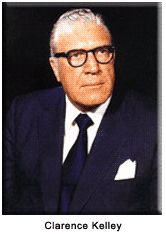 Kelley presided over the bureau until 1978, when William H. Webster was appointed director. Webster served until he was replaced by acting director John E. Otto in 1987. Later that year, Otto stepped down and was replaced by William S. Sessions. Sessions settled claims by African-American and Hispanic agents of racial discrimination and harassment. Sessions also implemented policies to increase the number of women and minorities in the bureau.
In 1993, President Bill Clinton dismissed Sessions amid allegations of unethical conduct. Clinton replaced Sessions with Louis J. Freeh, a former FBI agent and federal judge, until 2001, when Thomas J. Pickard was made acting director. Pickard was replaced by the FBI’s current director, Robert S. Mueller, III.
Conclusion
Through the years, the Federal Bureau of Investigation has been involved in the investigation and capture of many of the most treacherous criminals in American history. The FBI remains an evolving federal bureau with the widest authority and jurisdiction of any federal law enforcement agency.
Kelley presided over the bureau until 1978, when William H. Webster was appointed director. Webster served until he was replaced by acting director John E. Otto in 1987. Later that year, Otto stepped down and was replaced by William S. Sessions. Sessions settled claims by African-American and Hispanic agents of racial discrimination and harassment. Sessions also implemented policies to increase the number of women and minorities in the bureau.
In 1993, President Bill Clinton dismissed Sessions amid allegations of unethical conduct. Clinton replaced Sessions with Louis J. Freeh, a former FBI agent and federal judge, until 2001, when Thomas J. Pickard was made acting director. Pickard was replaced by the FBI’s current director, Robert S. Mueller, III.
Conclusion
Through the years, the Federal Bureau of Investigation has been involved in the investigation and capture of many of the most treacherous criminals in American history. The FBI remains an evolving federal bureau with the widest authority and jurisdiction of any federal law enforcement agency.